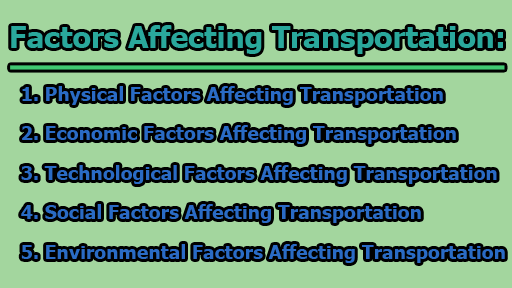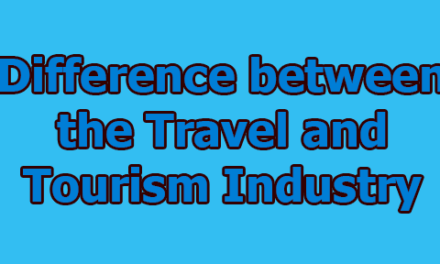Factors Affecting Transportation:
Transportation is a fundamental pillar of modern society, seamlessly connecting people and goods across the globe. However, this intricate web of mobility is subject to a multitude of influences that shape its structure and operation. The factors affecting transportation are as diverse as they are profound, encompassing the physical terrain of a region, economic considerations, technological innovations, societal norms, and environmental imperatives. Understanding the intricate interplay of these factors is essential for optimizing transportation systems, ensuring their sustainability, and meeting the ever-evolving demands of a dynamic world. In the rest of this article, we will explore the factors affecting transportation.
1. Physical Factors Affecting Transportation:
1.1 Geography: Geography plays a pivotal role in shaping transportation infrastructure and connectivity. It can either present opportunities or pose significant challenges:
- Barriers and Opportunities: Natural features such as mountains, deserts, and bodies of water can act as barriers to transportation, necessitating the construction of tunnels, bridges, or transportation networks that circumvent these obstacles. Conversely, they can also create opportunities for unique transportation modes, such as cable cars or ferries.
- Islands and Archipelagos: Islands, archipelagos, and coastal regions often rely heavily on water transportation due to the practicality of connecting these landforms by sea or air. Ports, harbors, and airports become crucial transportation hubs in such regions.
- Navigable Waterways: Rivers, canals, and lakes offer efficient and cost-effective options for transporting goods. The proximity to navigable water bodies can reduce the need for extensive road or rail networks.
1.2 Climate and Weather: Climate and weather conditions significantly impact transportation in several ways:
- Safety and Efficiency: Weather conditions such as rain, snow, fog, and storms can affect transportation safety and efficiency. These conditions may lead to reduced visibility, slippery road surfaces, and disrupted schedules for various transportation modes.
- Infrastructure Resilience: Infrastructure in regions prone to severe weather events, like hurricanes or heavy snowfall, must be designed and maintained to withstand these conditions. Snowplows, de-icing materials, and flood defenses are examples of infrastructure adaptations.
- Weather-Dependent Modes: Certain transportation modes, like air travel, are particularly sensitive to weather conditions. Fog or storms can lead to flight cancellations and delays, impacting passengers and cargo shipments.
1.3 Terrain and Topography: The local terrain and topography greatly influence the design and maintenance of transportation infrastructure:
- Flat Terrains: Flat and level terrains are more conducive to road construction and ease of travel. These areas are often preferred for highway networks and urban development due to their suitability for transportation.
- Hilly or Mountainous Terrains: Mountainous or hilly terrains require more engineering efforts, including the construction of tunnels, bridges, and switchback roads. These areas may pose challenges for transportation, but also offer opportunities for scenic routes and recreational travel.
- Slope Stability: The stability of slopes in mountainous regions is essential for maintaining road and rail networks. Landslides and rockfalls can disrupt transportation and require ongoing monitoring and mitigation efforts.
1.4 Proximity to Water Bodies: Areas located near water bodies can leverage water transportation for economic and logistical benefits:
- Waterborne Transportation: Proximity to oceans, seas, rivers, and lakes can facilitate water transportation, which is often cost-effective for moving bulk goods, such as raw materials, fuel, and commodities.
- Ports and Shipping Routes: Coastal regions with deepwater access tend to develop well-established ports and shipping routes. These areas become critical gateways for international trade and maritime transportation.
- Inland Waterways: Inland waterways, like navigable rivers, offer efficient transportation options for both bulk cargo and passengers. Barges and ferries play a crucial role in these regions.
1.5 Urban vs. Rural Environments: The level of urbanization in an area shapes transportation needs and options:
- Urban Environments: High population densities in urban areas necessitate efficient public transit systems, including buses, subways, trams, and commuter rail. Urban planning often emphasizes compact development and walkability to reduce the need for personal vehicles.
- Rural Areas: Rural regions may rely more on personal vehicles due to lower population densities and limited public transit options. Long distances between destinations and a lack of centralized infrastructure are common challenges in rural transportation.
- Suburban Areas: Suburban areas often represent a blend of urban and rural characteristics, with residents commuting to urban centers while using personal vehicles for local travel. Suburbs may also develop their own transit systems.
2. Economic Factors Affecting Transportation:
2.1 Economic Development: The level of economic development in a region has a profound impact on its transportation infrastructure:
- Developed Economies: Regions with well-developed economies tend to have well-maintained transportation networks, including roads, railways, airports, and ports. These systems are often highly efficient and well-connected.
- Developing Regions: In contrast, developing regions may face challenges such as limited transportation infrastructure, poorly maintained roads, and inadequate public transit systems. Investment in transportation infrastructure is a crucial part of economic development for these areas.
- Deteriorating Networks: In some cases, even in developed economies, aging infrastructure may lead to deterioration and a need for substantial investment to maintain or upgrade transportation networks.
2.2 Cost and Funding: The cost of building and maintaining transportation infrastructure is a critical consideration, and funding sources play a vital role:
- Public Funding: Governments at various levels (local, regional, and national) allocate public funds for transportation projects. These funds may come from taxes, fees, or bonds. The availability of public funding can significantly impact the pace and quality of infrastructure development.
- Private Investment: Private investors, including companies and consortia, may invest in transportation projects through public-private partnerships (PPPs). Private funding can accelerate the development of transportation infrastructure and reduce the burden on public budgets.
- International Funding: International organizations, such as the World Bank or regional development banks, often provide financial support for transportation projects in developing regions. These funds help bridge the infrastructure gap in less economically advanced areas.
- Toll Roads and User Fees: Some transportation infrastructure, like toll roads and bridges, relies on user fees to cover construction and maintenance costs. These fees can affect the accessibility of certain routes.
2.3 Market Demand: The transportation industry is highly responsive to market demand. The types and quantities of goods and services that need to be transported influence the capacity and efficiency of transportation systems:
- E-commerce: The growth of e-commerce has driven significant changes in transportation. The demand for faster and more reliable delivery services, as well as last-mile logistics, has reshaped the industry and led to innovations like same-day delivery and autonomous delivery vehicles.
- Supply Chain Efficiency: Efficient transportation is crucial for supply chain management. Businesses strive to minimize transportation costs while ensuring the timely delivery of products to meet consumer demands. This involves optimizing logistics, inventory management, and transportation routes.
2.4 Fuel Prices: Fluctuations in fuel prices impact the operating costs of transportation modes, particularly road and air travel:
- High Fuel Prices: When fuel prices are high, it increases operating costs for transportation companies and can lead to increased ticket prices for consumers. This can affect the affordability of travel and the competitiveness of businesses reliant on transportation.
- Impact on Modes: High fuel prices often lead to a shift in mode preferences. Consumers may opt for more fuel-efficient vehicles, public transit, or carpooling when fuel prices are elevated.
2.5 Trade and Globalization: The expansion of international trade and globalization has had a significant impact on transportation:
- Logistics and Supply Chains: The growth of international trade has led to the development of extensive logistics and supply chain networks. Transportation is a crucial component of these networks, ensuring the movement of goods across borders efficiently and cost-effectively.
- Efficiency and Cost Reduction: The transportation industry plays a key role in enhancing the efficiency of global trade. Just-in-time delivery and reduced inventory costs are made possible by efficient transportation systems.
- Trade Agreements and Tariffs: International trade agreements and tariffs can impact transportation patterns. Changes in trade policies, such as tariff adjustments, may influence the flow of goods and the choice of transportation routes.
- Global Distribution Networks: Companies are establishing global distribution networks to reach consumers worldwide. Efficient transportation links are essential for this purpose.
3. Technological Factors Affecting Transportation:
3.1 Vehicle Technology: Advances in vehicle technology have revolutionized transportation in numerous ways:
- Electric Vehicles (EVs): The development of electric vehicles has had a transformative impact on road transportation. EVs are powered by electricity, produce zero tailpipe emissions, and are increasingly popular due to their environmental benefits. As battery technology improves, the range of EVs continues to increase, making them a viable option for a broader range of consumers.
- Autonomous Vehicles (AVs): Autonomous or self-driving vehicles represent the cutting edge of transportation technology. These vehicles are equipped with sensors, cameras, and artificial intelligence to navigate without human intervention. AVs have the potential to increase road safety, reduce congestion, and improve mobility for individuals with disabilities or limited mobility.
- Fuel-Efficient Engines: Conventional internal combustion engines are becoming more fuel-efficient, reducing emissions and dependence on fossil fuels. Technologies such as direct injection, turbocharging, and variable valve timing enhance engine efficiency.
- Hybrid Vehicles: Hybrid vehicles combine internal combustion engines with electric propulsion, providing improved fuel economy and reduced emissions. They are increasingly popular as a transitional technology towards fully electric vehicles.
3.2 Communication and Information Technology: Information and communication technology (ICT) is integral to optimizing transportation systems:
- GPS Navigation: GPS (Global Positioning System) technology enables precise location tracking, improving route planning and navigation for drivers, cyclists, and pedestrians. Navigation apps provide real-time traffic data and suggest alternative routes to avoid congestion.
- Real-Time Tracking: Real-time tracking systems, often integrated with GPS technology, allow transportation operators to monitor vehicles, cargo, and passengers. This enhances safety, security, and logistics.
- Data Analytics: Data analytics tools are used to collect and analyze transportation data. This includes traffic flow, vehicle performance, and passenger behavior. Analyzing this data can optimize transportation systems, reduce congestion, and improve safety.
- Connected Vehicles: Vehicle-to-vehicle (V2V) and vehicle-to-infrastructure (V2I) communication enable vehicles to share information about their speed, location, and intentions with each other and with road infrastructure. This can improve safety and traffic management.
3.3 Transportation Infrastructure: The development of transportation infrastructure is pivotal to transportation:
- High-Speed Rail: High-speed rail systems, found in various countries, offer a rapid and sustainable alternative to air and road travel for intercity transportation. They reduce travel times and ease congestion on major highways and at airports.
- Modern Airports: Modern airports are equipped with advanced technologies to enhance passenger experiences, streamline security procedures, and improve air traffic management. This includes self-check-in kiosks, automated baggage handling, and biometric security screening.
- Intelligent Traffic Management Systems: These systems use real-time data from sensors and cameras to monitor and control traffic flow. Adaptive traffic signals, variable speed limits, and dynamic message signs are used to reduce congestion and enhance safety.
- Smart Ports: Ports are increasingly implementing smart technologies to manage cargo operations efficiently. This includes the use of automated cranes, container tracking systems, and optimized logistics.
3.4 Alternative Fuels: The exploration of alternative fuels is driven by environmental concerns and a desire to reduce reliance on fossil fuels:
- Biofuels: Biofuels are produced from renewable organic materials such as corn, sugarcane, or algae. They can be used as a substitute for traditional gasoline and diesel fuels, reducing greenhouse gas emissions.
- Hydrogen: Hydrogen is considered a promising alternative fuel for transportation. It can be used in fuel cell vehicles (FCVs), which produce electricity through a chemical reaction between hydrogen and oxygen, emitting only water vapor as a byproduct.
- Natural Gas: Natural gas is a cleaner-burning fuel than gasoline or diesel. Compressed natural gas (CNG) and liquefied natural gas (LNG) are used as alternative fuels in various types of vehicles, including buses and trucks.
3.5 Digital Platforms: Digital platforms are transforming the way people access and use transportation services:
- Ride-Sharing Services: Companies like Uber and Lyft provide on-demand, shared transportation services using smartphone apps. They have disrupted the traditional taxi industry and offered new options for urban transportation.
- Mobility-as-a-Service (MaaS): MaaS platforms integrate various transportation options, including public transit, ride-sharing, bike-sharing, and car rentals, into a single digital platform. This enables users to plan, book, and pay for their entire journey in one place, promoting multimodal transportation.
- Car-sharing: Car-sharing services like Zipcar allow users to rent vehicles for short periods, reducing the need for personal car ownership and encouraging a shared mobility model.
4. Social Factors Affecting Transportation:
4.1 Demographics: Demographics, which encompass the age, population size, and distribution of a region’s residents, have a substantial influence on transportation preferences and needs:
- Aging Populations: Regions with a larger proportion of older residents may require more accessible and senior-friendly transportation options. This includes accessible public transit, paratransit services, and options for individuals with reduced mobility.
- Population Density: Urban areas with high population density often necessitate efficient and extensive public transit systems due to the challenges of traffic congestion and limited space for personal vehicles.
- Suburban and Rural Areas: Suburban and rural regions may lean more on personal vehicles due to longer travel distances and less developed public transportation networks.
4.2 Cultural Practices: Cultural factors can significantly shape transportation choices. Different cultures have distinct preferences and practices related to mobility:
- Car Culture: In some cultures, there’s a strong affinity for personal cars as a symbol of status and freedom. This car culture may lead to a heavy reliance on automobiles for daily commuting.
- Cycling and Walking: Other cultures prioritize cycling and walking as common modes of transportation, with dedicated infrastructure and societal norms that encourage these practices.
- Public Transit Culture: Some regions have well-established public transit cultures, where a significant portion of the population uses buses, trams, subways, and trains for daily commuting.
- Carpooling and Ride-Sharing: Certain cultures embrace carpooling and ride-sharing as a way to reduce congestion and environmental impact.
4.3 Work Patterns: Work patterns are evolving, and changes in the way people work impact commuting and travel behaviors:
- Remote Work: The COVID-19 pandemic accelerated the trend of remote work. As more people work from home, there may be reduced demand for daily commuting and an increased reliance on digital platforms for virtual meetings.
- Flexible Hours: The adoption of flexible work hours allows commuters to avoid rush-hour traffic and choose times that are more convenient for them.
- Commuting Alternatives: Some organizations encourage alternative forms of commuting, such as telecommuting, compressed workweeks, or staggered shifts to alleviate peak-hour congestion.
4.4 Social Equity: Social equity is a critical consideration in transportation planning, focusing on ensuring that transportation options are inclusive and affordable for all members of society, regardless of income or physical abilities:
- Affordable Transportation: Access to affordable transportation is essential for socio-economic mobility. For low-income individuals and families, public transit subsidies, reduced fare programs, and shared mobility options can be crucial.
- Accessibility: Transportation infrastructure must be designed to accommodate individuals with physical disabilities. This includes wheelchair-accessible buses, train stations, and properly maintained sidewalks and crosswalks.
- Access to Opportunities: Transportation networks should provide equal access to job opportunities, education, healthcare, and social services. Addressing transportation deserts in underserved communities is a priority.
4.5 Public Perception and Attitudes: Public perception of transportation options can significantly influence people’s choices and behaviors:
- Safety: The perceived safety of a transportation mode is a crucial factor. Negative perceptions of safety can deter people from using specific modes, such as cycling or public transit.
- Reliability: The reliability of transportation services, including on-time performance and the availability of transportation options, impacts whether people choose to use them.
- Environmental Impact: Public awareness of the environmental impact of transportation choices, such as emissions and pollution, can drive individuals to choose more sustainable options.
- Technological Advancements: Public attitudes toward new technologies, like autonomous vehicles, can affect their adoption and integration into transportation systems.
5. Environmental Factors Affecting Transportation:
5.1 Environmental Regulations: Environmental regulations play a pivotal role in shaping the transportation industry by imposing restrictions and standards to mitigate the environmental impact of transportation activities. These regulations are implemented by governments worldwide to reduce emissions and promote more sustainable transportation practices. Here are some key aspects to consider:
- Emission Standards: Governments set specific emission standards for vehicles, particularly in terms of pollutants like carbon monoxide (CO), nitrogen oxides (NOx), and particulate matter. Vehicle manufacturers must comply with these standards, leading to the development of cleaner and more fuel-efficient technologies.
- Fuel Efficiency Requirements: Many countries have fuel efficiency requirements that mandate automakers to produce vehicles with higher miles per gallon (MPG) ratings. This encourages the development of more efficient engines and the use of alternative fuels, such as electric, hybrid, and hydrogen-powered vehicles.
- Carbon Pricing and Taxes: Some regions impose carbon pricing mechanisms or taxes on transportation fuels. This can influence consumer behavior by making fossil fuel-powered vehicles more expensive to operate and encouraging a shift towards greener alternatives.
- Greenhouse Gas (GHG) Reduction Targets: Governments are setting targets to reduce greenhouse gas emissions, and transportation is a significant contributor to these emissions. These targets drive research and development in electric and fuel-efficient vehicles, as well as alternative energy sources for transportation.
5.2 Climate Change: Climate change is a pressing global issue, and transportation is both a contributor to and a victim of the changing climate. As such, there is a growing emphasis on developing eco-friendly transportation options:
- Electric Vehicles (EVs): The development and adoption of electric vehicles have gained momentum as they produce zero tailpipe emissions. EVs have the potential to significantly reduce the carbon footprint of personal transportation.
- Improved Public Transit: Expanding and enhancing public transit systems, including buses and trains, can reduce the number of individual vehicle journeys and lower emissions. Electric buses and trains powered by clean energy sources contribute to sustainable public transit options.
- Reduced Fossil Fuel Dependency: As the effects of climate change become more evident, there is an increasing push to reduce reliance on fossil fuels. This involves transitioning to cleaner fuels, like natural gas, hydrogen, and biofuels, as well as promoting alternative modes of transportation, such as cycling and walking.
5.3 Air Quality: Air quality is a significant concern, especially in densely populated urban areas. Transportation emissions, particularly from vehicles with internal combustion engines, significantly contribute to poor air quality, which can lead to a range of health problems:
- Particulate Matter (PM) and NOx Emissions: Internal combustion engines produce fine particulate matter and nitrogen oxides that can lead to respiratory issues and other health problems when released into the atmosphere.
- Health Impacts: Poor air quality resulting from transportation emissions is linked to health conditions such as asthma, bronchitis, cardiovascular diseases, and even premature mortality.
- Urban Planning and Zoning: To address air quality concerns, urban planners are focusing on mixed-use development and transit-oriented design. These strategies encourage more people to use public transit or walk, reducing the number of vehicles on the road.
5.4 Sustainability and Green Transportation: Sustainability is at the forefront of transportation planning and innovation, leading to the development of various green transportation options:
- Cycling Lanes: Many cities are expanding their cycling infrastructure by adding dedicated lanes and bike-sharing programs, promoting sustainable and healthy transportation.
- Electric Buses and Trains: The electrification of public transit is gaining ground. Electric buses and trains offer efficient and low-emission options for urban and regional transportation.
- Renewable Energy Integration: Transportation infrastructure is increasingly being powered by renewable energy sources such as solar, wind, and hydropower. Electric vehicle charging stations are often integrated with renewable energy systems.
5.5 Resource Availability: The sustainability and feasibility of transportation projects are heavily influenced by the availability of key resources:
- Rare Metals for Batteries: The development and expansion of electric vehicles rely on access to rare metals like lithium and cobalt. Ensuring a steady supply chain for these resources is crucial to sustaining the electric vehicle industry.
- Clean Water for Ship Navigation: Water transportation, particularly in the shipping industry, relies on clean waterways and harbors. Pollution, invasive species, and industrial runoff can disrupt water navigation.
- Land for Road Construction: Land availability is essential for the construction and expansion of road networks. Urban areas, in particular, face challenges in securing the necessary land for road infrastructure development.
In conclusion, transportation is a multifaceted system influenced by a wide range of factors. These factors interact and shape the way people and goods move in our interconnected world. Addressing transportation challenges often involves a combination of technological innovation, policy development, and consideration of environmental and social impacts. As society continues to evolve, the transportation sector will adapt to meet the changing needs and expectations of individuals and communities.

Former Student at Rajshahi University










